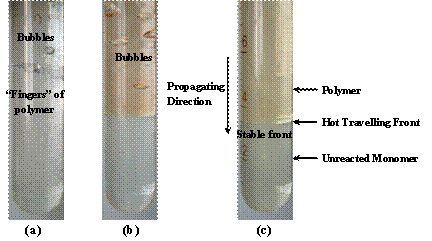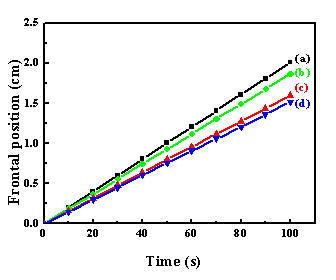501g Influences of Redox Initiators on Free-Radical Frontal Polymerization of Poly(hydroxyethyl acrylate)
Redox initiation, also known as redox catalysis, or redox activation can be used to initiate polymerization relying on the free radicals producing in the course of oxidation-reduction reaction. A prime advantage of redox initiators is that their relative lower activation energy of the reaction can result in radical production at reasonable rates over a very wide range of temperatures, including initiation at moderate temperatures of 0-50 oC and even lower [1]. Redox initiation has been widely employed in free-radical polymerization [2,3]. However it has not been investigated in frontal polymerization (FP) thoroughly.
FP is an easy method of manufacturing materials with the advantages of short-time, high reaction rate and energy-saving [4-6]. In 1972, the first FP reactions were discovered by Chechilo and Enikolopyan, who studied methyl methacrylate (MMA) polymerization under high pressure (>3000 atm) [7]. Subsequently, this method was extended by Pojman and his co-workers to include numerous polymers [8].
Recently, the overwhelming majority of frontal polymerization work has been focused on free-radical polymerization system. By now, the challenge for FP is how to discover the efficient initiators, which can greatly decrease the triggering temperature and front temperature, allowing more monomers with the lower boiling point to polymerize without bubbles. Unfortunately, in many cases, the reported approaches on FP employ monomers and solvents whose boiling points are usually larger than their maximum front temperature to avoid bubbles occurrence during FP, thereby limiting performance of low boiling point monomers by FP. A number of redox reactions may be employed for solving this problem. To the best of our knowledge, few studies have been so far focused on studying redox initiator for free-radical frontal polymerization of poly(hydroxyethyl acrylate) (PHEA). Here, we focused on how to use redox initiator to synthesize poly (hydroxyethyl acrylate) (PHEA) by free-radical frontal polymerization at ambient pressure.
The oxidant BPO and reductant DMA (Aldrich) were dissolved in DMSO (Aldrich), and then intimately mixed with the appropriate amount of HEA (Aldrich) at ambient temperature in a flask. The flask was shaken vigorously in order to obtain a homogeneous solution. Then, the mixture was poured into a 10 mL (D = 15 mm) glass test tube. The reaction mixture was kept at about 18 - 25 oC in order to slow bulk polymerization. The upper side of the mixture was then heated by a soldering iron at 40 oC until the hot propagating front commenced.
We choose the oxidant BPO in conjunction with the reductant DMA as initiator to synthesize PHEA by FP due to oxidation-reduction reaction mechanism. In BPO/DMA system, radical production appears to proceed via an initial ionic displacement by the nitrogen of the aniline on the peroxide linkage [1]. Radical formation is illustrated in Scheme 1.
In order to evaluate the effect of redox initiator on FP, the experiments were conducted at a constant concentration of oxidant (BPO = 0.32 wt %) and [HEA]/[DMSO] = 2.69, while the [DMA]/[BPO] ratio was adjusted by varying the concentration of DMA. As shown in Figure 1, when the reaction was initiated only by BPO at 80 oC, polymer front propagated in the form of variable bubbles and the phenomenon of "fingers" could be clearly seen in Figure 1a. The source of some large bubbles may be a result of the decomposition of BPO. However, the phenomenon of "fingers" disappeared at [DMA]/[BPO] = 0.5, but bubbles still occurred (Figure 1b). We speculate that liberation of carbon dioxide still derives from the decomposition of BPO in part. Interestingly, the bubble formation can be completely inhibited by increasing DMA concentration at [DMA]/[BPO] = 1 (Figure 1c), even at higher [DMA]/[BPO] ratio, while FP is initiated at 40 oC. Meanwhile, we can see that as the DMA concentration is increased, the color of the polymers obtained becomes darker in good agreement the result of the reported reference [9].

Scheme 1 Reaction mechanism of BPO with DMA

Fig. 1 Visual image illustrating the polymerization front of PHEA with various [DMA]/[BPO] ratios. Initial conditions: [HEA]/[DMSO] = 2.69, BPO = 0.32 wt % , (a) [DMA]/[BPO] = 0; (b) [DMA]/[BPO] = 0.5; (c) [DMA]/[BPO] = 1 (inner diameter of the tube is 15 mm).
The position of the front as a function of time is given in Figure 2 with different ratios of [DMA]/[BPO]. We can see that an increase of the [DMA]/[BPO] ratio does decrease the front velocity from 1.2 cm/min to 0.9 cm/min. While the [DMA]/[BPO] ratio is more than 1, excess reductant has a retarding effect on the front velocity. One possibility is that a high concentration of DMA causes further reduction of radicals into anions before the polymerization take place. It may exist that there is the optimized ratio of [DMA]/[BPO] in this case.

Fig. 2 Front position vs. reaction time for PHEA prepared by FP at [HEA]/[DMSO] = 2.69, BPO = 0.32 wt %, (a) [DMA]/[BPO] = 1; (b) [DMA]/[BPO] = 2; (c) [DMA]/[BPO] = 4; (d) [DMA]/[BPO] = 6.
The front temperature is plotted in Figure 3 as a function of the [DMA]/[BPO] ratio at [HEA]/[DMSO]= 2.69, BPO = 0.32 wt%. It is observed that an increase of the [DMA]/[BPO] ratio caused a decrease of front temperature more than 50 oC. The Tmax monotonically decreases with the [DMA]/[BPO] ratio. The front temperature depends on a combination of factors, such as the enthalpy of the reaction, the heat capacity of the product, and heat loss to the surroundings. Thus, the decrease of Tmax is related to the reduction in the rate of the heat producing reaction and to the decreased velocity that prolongs the time for heat loss under nonadiabatic conditions.

Fig. 3 Tmax of PHEA prepared by FP vs. the [DMA]/[BPO] ratio at [HEA]/[DMSO]= 2.69; BPO = 0.32 wt%.
A thorough study on the effect of BPO/DMA couple as redox initiator on the synthesis of PHEA by free-radical frontal polymerization at ambient pressure was performed. Our preliminary experiments show that the self-sustaining and stable front can be obtained at the [DMA]/[BPO] ratio = 1, while the phenomenon of bubbles and "fingers" in FP initiated only by BPO. We found that the front velocity and temperature monotonically decreases with the increaseing [DMA]/[BPO] ratio (more than 1). Significantly, a slight increase of the reductant DMA concentration caused a remarkable decrease of front temperature more than 50 oC. In this sense, FP initiated by redox initiators opens the way to the potential development of FP by using more appropriate monomers with low boiling point.
Keywords: redox initiation, free-radical frontal polymerization, Poly(hydroxyethyl acrylate)
Acknowledge: The authors would like to thank the National Natural Science Foundation of China for financial support (No. 20606016, 20576053), NSAF (No. 10676013), and Natural Science Foundation for Jiangsu Higher Education Institutions of China (Grant No. 07KJA53009).
Reference
[1] G. Odian, Wiley-Interscience: Hoboken, New Jersey, (2004) 198-348.
[2] A. S. Sarac, Prog. Polym. Sci., 24 (1999) 1149-1204.
[3] K. F. O'Driscoll and E. N. Ricchezza, Die Makromolekulare Chemie, 47 (1961) 15-18.
[4] S. Chen, J. J. Sui, L. Chen and J. A. Pojman, J Polym Sci Part A: Polym Chem, 43 (2005) 1670-1680.
[5] S. Chen, Y. Tian, L. Chen and T. Hu, Chem. Mater., 18 (2006) 2159-2163.
[6] L. Chen, T. Hu, H. Yu, S. Chen, and J. A. Pojman, J Polym Sci Part A: Polym Chem, 45 (2007) 4322-4330.
[7] N. M. Chechilo, R. J. Khvilivitskii and N. S. Enikolopyan, Dokl. Akad. Nauk SSSR, 204 (1972) 1180-1181.
[8] J. A. Pojman, J. Am. Chem. Soc., 113 (1991) 6284-6286.
[9] U. Yildiz and B. Hazer, Polymer, 41 (2000) 539-544.